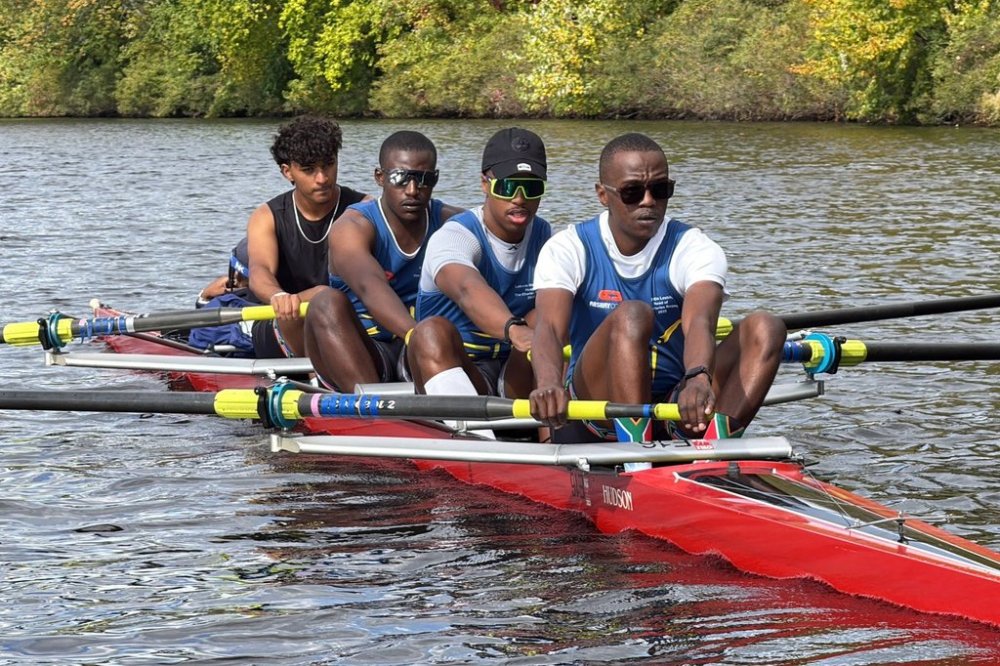World
South African Rowers Make Historic Debut at Head of the Charles

Four South African rowers have made history this weekend by becoming the first crew of color from their country to compete at the prestigious Head of the Charles Regatta in Boston. Their participation is significant not only for South African rowing but also reflects a broader movement towards increasing diversity in a sport traditionally dominated by white athletes.
The Head of the Charles, now in its 60th year, has seen a concerted effort to open its doors to a more diverse array of participants. This weekend’s event is a culmination of initiatives aimed at expanding access to rowing, a sport that has often excluded large segments of the population in both South Africa and the United States. Historically, competitive rowing has its origins in English colonialism, which created barriers to participation for many communities.
Among the competitors is Lwazi-Tsebo Zwane, a 23-year-old rower from Germiston, located east of Johannesburg. Zwane expressed the importance of their presence as role models for younger athletes. “It takes a lot to be at this regatta,” he said, competing in the Men’s Championship 4+ event. “There’s been a lot of pitfalls, there’s been a lot of barriers.”
Zwane, representing Western Cape Rowing, highlighted the legacy of poverty and economic inequality stemming from the apartheid era in South Africa. He noted that these historical factors have contributed to a narrative of oppression and second-class status for many individuals of color. “Doing the work to get there is not an easy feat,” he remarked, emphasizing the need to change the prevailing narratives.
The challenges faced by rowers from underrepresented backgrounds are echoed by Arshay Cooper, whose foundation played a key role in facilitating the South African team’s participation at the regatta. Cooper, who was part of America’s first all-Black high school rowing team, pointed out that many rowers encounter structural limitations, including lack of access to waterways and expensive equipment. “There’s talent everywhere, but not a lot of access and opportunity,” he stated.
In both South Africa and the U.S., public schools often provide rowing programs that attract athletes of color. However, these programs frequently lack the resources and experienced coaches that private institutions offer, making competition difficult. A 2016 analysis by U.S. Rowing indicated that the typical rower is often perceived as being “white and from a middle or upper-class suburban community.”
The NCAA reported in a 2021 study that among female collegiate rowers, only 2% identified as Black, while 5% identified as Hispanic and 3% as Asian. This statistic places rowing among the least diverse sports surveyed.
Denise Aquino, a co-founder of the nonprofit podcast Rowing in Color, noted that for many rowers of color, being the sole representative of their background in a crew is not uncommon. “We’re trying to add new faces to the sport,” she said, highlighting their commitment to social issues alongside competitive success.
The initiative also sees athletes using their platform to raise awareness. Last year, the first-ever indigenous four at the regatta raced with painted hands on their oars to honor murdered and missing indigenous women. Aquino mentioned that recent policies limiting government diversity and inclusion initiatives in the U.S. have increased their urgency to succeed, saying, “We’re definitely feeling that sense of fear, but also we’re going to do it anyway.”
Coaching at a university level in Cape Town, Michael Ortlepp explained that many of his athletes face significant challenges just to reach practice. Many come from previously segregated townships where public transport is unreliable, and some struggle to find stable housing. “Those are common stories; they’re not rare,” Ortlepp said of the hardships faced by his rowers.
Zwane’s journey to compete in Boston underscores these challenges. He began rowing at age 14 and now takes multiple minibuses daily to reach Victoria Lake, a stark contrast to the well-equipped facilities in Boston. “It does feel a little bit disorientating to be in this environment because this is everyone’s day-to-day, just normal life. For a lot of kids like me, it’s a luxury,” he shared.
His experience at the Head of the Charles serves as a reminder of the obstacles that continue to persist, but also of the potential for change in a sport eager to embrace a more inclusive future. The South African rowers’ historic debut not only marks a milestone in their own careers but also paves the way for future generations in rowing, proving that with determination and support, barriers can be broken.
-

 Science2 months ago
Science2 months agoToyoake City Proposes Daily Two-Hour Smartphone Use Limit
-

 Health2 months ago
Health2 months agoB.C. Review Reveals Urgent Need for Rare-Disease Drug Reforms
-

 Top Stories2 months ago
Top Stories2 months agoPedestrian Fatally Injured in Esquimalt Collision on August 14
-

 Technology2 months ago
Technology2 months agoDark Adventure Game “Bye Sweet Carole” Set for October Release
-

 World2 months ago
World2 months agoJimmy Lai’s Defense Challenges Charges Under National Security Law
-

 Technology2 months ago
Technology2 months agoKonami Revives Iconic Metal Gear Solid Delta Ahead of Release
-

 Technology2 months ago
Technology2 months agoSnapmaker U1 Color 3D Printer Redefines Speed and Sustainability
-

 Technology2 months ago
Technology2 months agoAION Folding Knife: Redefining EDC Design with Premium Materials
-

 Technology2 months ago
Technology2 months agoSolve Today’s Wordle Challenge: Hints and Answer for August 19
-

 Business2 months ago
Business2 months agoGordon Murray Automotive Unveils S1 LM and Le Mans GTR at Monterey
-

 Lifestyle2 months ago
Lifestyle2 months agoVictoria’s Pop-Up Shop Shines Light on B.C.’s Wolf Cull
-

 Technology2 months ago
Technology2 months agoApple Expands Self-Service Repair Program to Canada








